Slaughter something prettier-3
And here, perhaps, the time will “strike at the memories” and tell about how I first became acquainted with cold weapons and where I had an interest in him. It turned out that I grew up in an old wooden house 1882, built with a bunch of sheds and cellars, in which nothing was stored. My grandfather had an 1895 HDD he received when he traveled with a food squad to knock out bread from the peasants, a bayonet from Gra’s rifle, which he was given to this rifle, not caring that he didn’t fit the trunk - I mowed nettle in the garden and burdocks, and still at home there was a completely eerie-looking dagger with a rhombic blade, a twisted cross hair, a bone handle and a wooden scabbard covered with black varnish. My uncle found him, who died later in the war, and my grandfather told me that he found him in the cemetery and he was all covered in blood. My grandfather taught me to throw him at the target, at the wall of the shed and ... then I showed it to some of my classmates for what purpose.
Having read "Dirk", I cut an encrypted inscription on the sheath: "This dagger was found in the cemetery", which is why its value has increased dramatically, and I, as a student, sold it to a collector. So how to keep such horror at home in Soviet times was simply dangerous!
And then my mother got married again, and it turned out that her elect was a former officer of the Polish Army and part-time Soviet military intelligence Peter Shpakovsky. Later, in the novel “We Will Die Under Moscow”, he will be bred under the name of Peter Skvortsovsky, well, and then (and I was studying at the time in ninth grade), familiarity with such a person naturally interested me well, just before stuttering. Houses - a museum! Pictures from the Dresden Gallery ("awards from Marshal Rokossovsky"), a bunch of all "antiques", the saber of the German general - "he gave me!" And, finally - a Japanese dagger. He thought it was a wakizashi, but now I know for sure that it was tanto. And he got it in a duel with a German officer, who is also described in the novel and ... took him off as a trophy! I also got a cigar-pipe (!), A parabellum, a tablet with papers and this very dagger that hung on his belt. Looks like a German was a fool and a dude, for which he paid! And, of course, I wanted to learn more about it, began to read the relevant books, and so I got carried away. Well, now for this there is also the Internet!
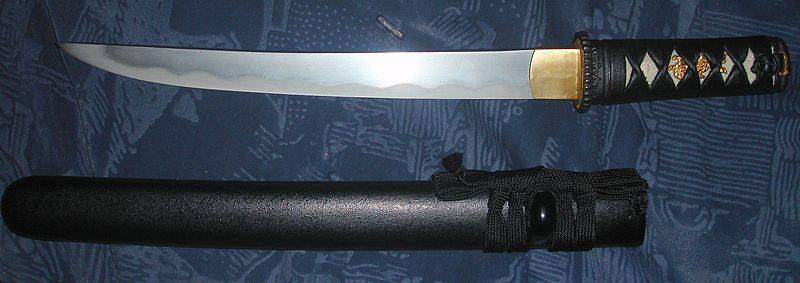
This is what the tanto dagger looked like from my distant childhood.
True, my dagger did not have a braid on the handle - it was completely covered with shark skin and looked very simple, but the sheath was very beautiful. Bamboo was masterfully discharged under the wind in black gold lacquer, and under the bamboo there was a tiny demon cast from bronze and attached to the sheath. His teeth were silver, his wrist bracelets were gold, and his eyes were rubies. And all this is about the size of a nail!
So without the Japanese theme, we are, as they say, “nowhere”, but before talking about the Japanese blades, we should at least return to the past. So, in the previous material it was told about daggers chilanum, but there was no “picture”. In addition, these daggers are not only in the exposition of the Metropolitan Museum in New York, but also in many others. For example, this Indian dagger from Dean, South India, 1500-early 1600. located in Higgins Arsenal, in Worcester County, Massachusetts. But today it is closed, so it's useless to go there, but thanks to the Internet we can see it. It is interesting, first of all, its typing. The dagger is all-metal, weighs one pound and is decorated with blacksmith work and gold and silver notch.

And here is another such dagger already from the Louvre. And what can you say about him, speaking the language of our time? Solid show off! Because his entire arm, together with the guard, is carved out of a milky-white stone. Stone! That is, in any case, this thing is fragile, because it is thin. Wearing it on a belt on the background of a colored robe, probably, was very effective, but it is hardly possible to use it in battle.
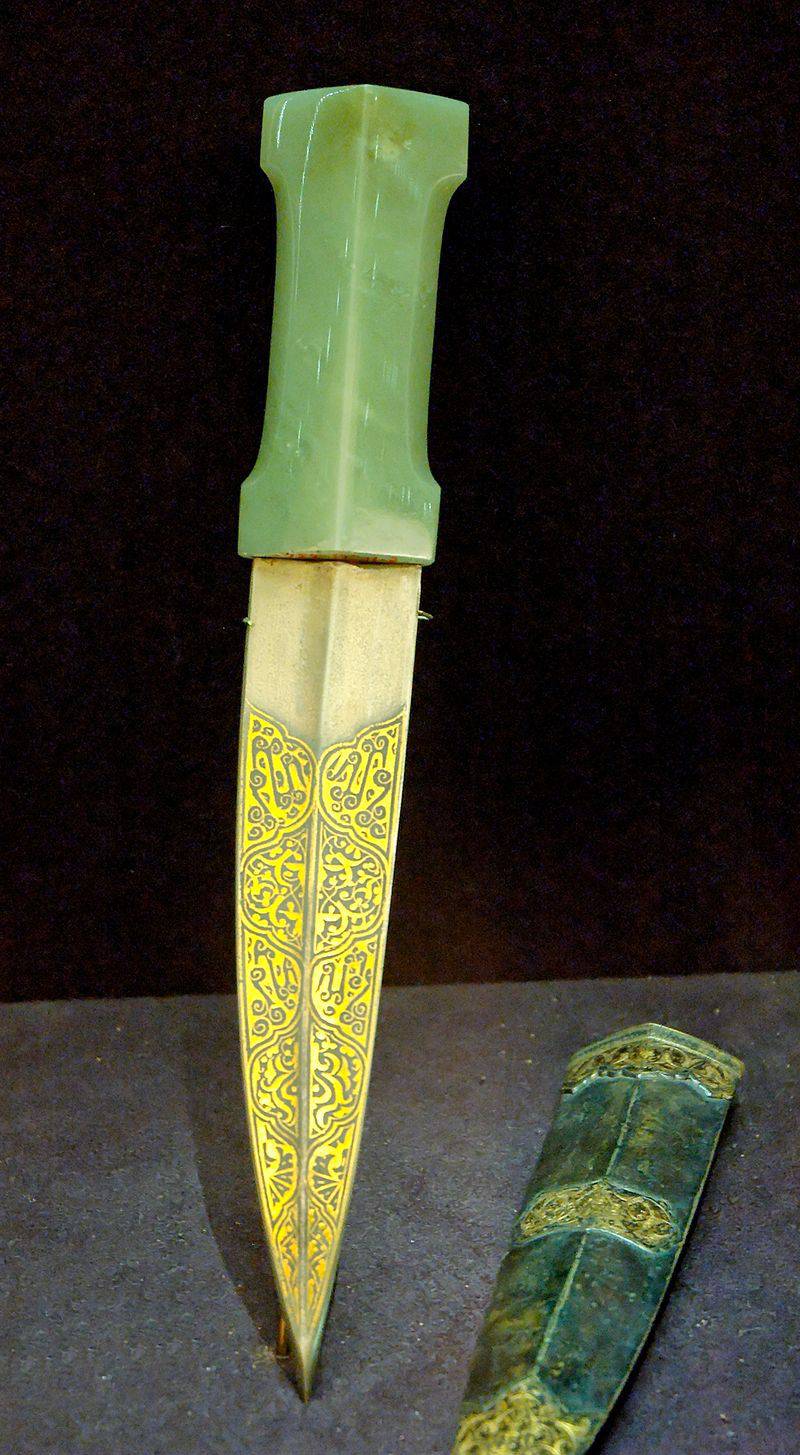
Another Indian dagger, also from the Louvre and also with a stone handle. The handle is simple, massive, and the master decided not to decorate it. But on the blade worked from the heart, so that even sharpen it and that ... scary. Well how do you spoil such beauty?
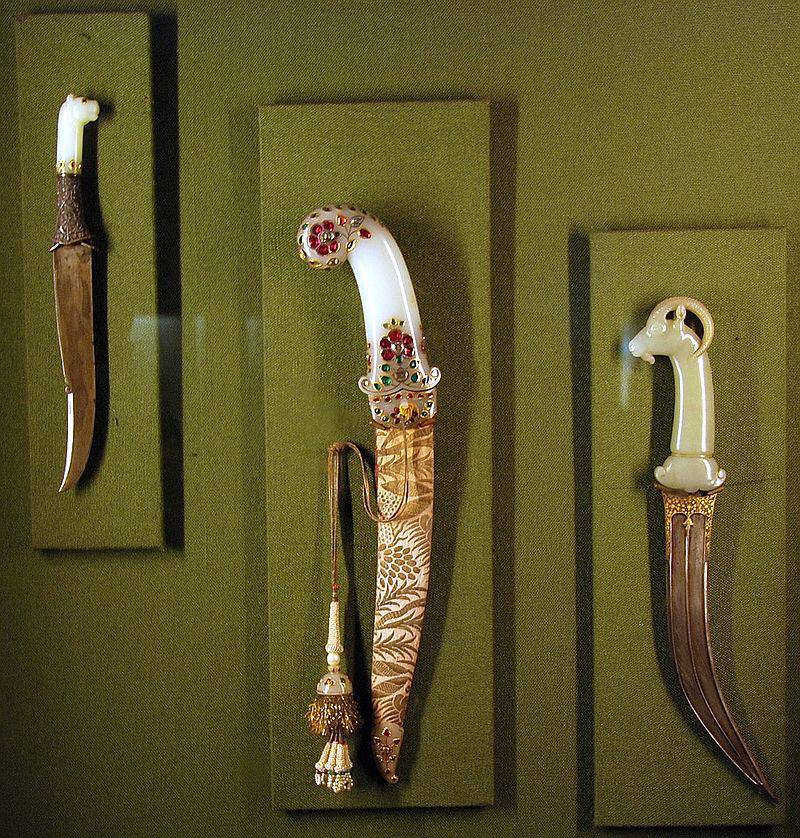
Here are daggers from the Prince of Wales Museum in the city of Mumbai in India. Now everyone is changing (talking) Turkey and Egypt to India, Vietnam and Borneo, so that those who go to Mumbai (or Mumbai) can see them. Again, chalcedony, carnelian, rubies, emeralds - everything that is rich in India, went to their decoration. Moreover, the most amazing thing is that the handle on the left dagger ends with the dog’s head, and the mountain goat on the right. Well, okay horses, okay dogs ... But why a goat?
One of the commentators of the previous material wrote that due to its size and the fact that jambia-type daggers were worn under the belt, they could play the role of ... body armor! This is a controversial statement, but if you really look at the photos of the same Yemenis with their daggers in their belts, then this may well come to mind.
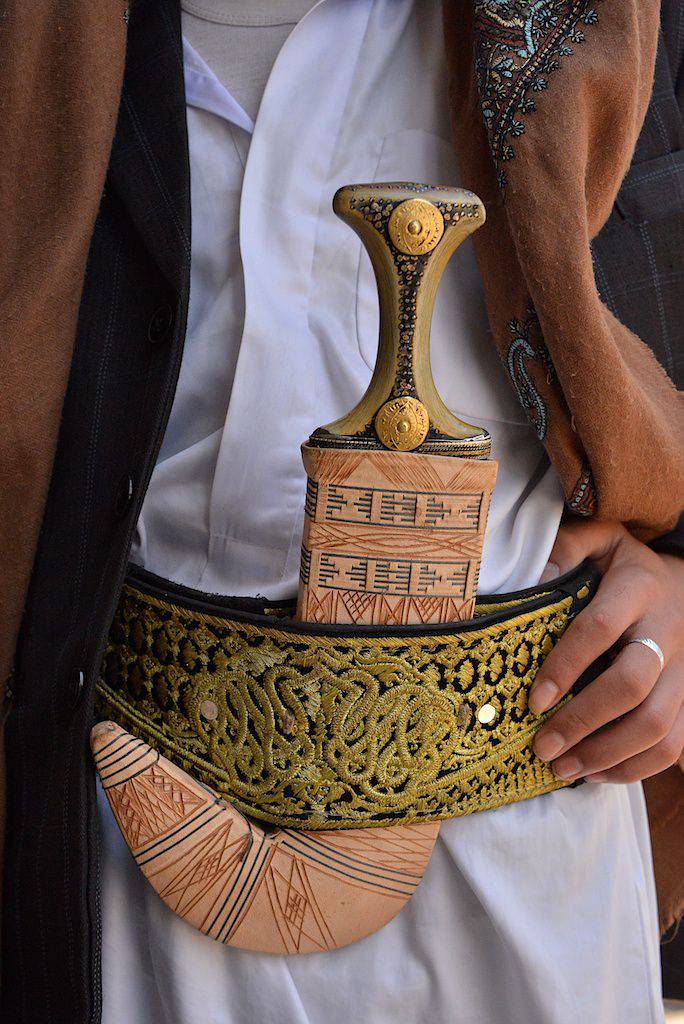
Typical Yemeni man. Rather, its middle part.
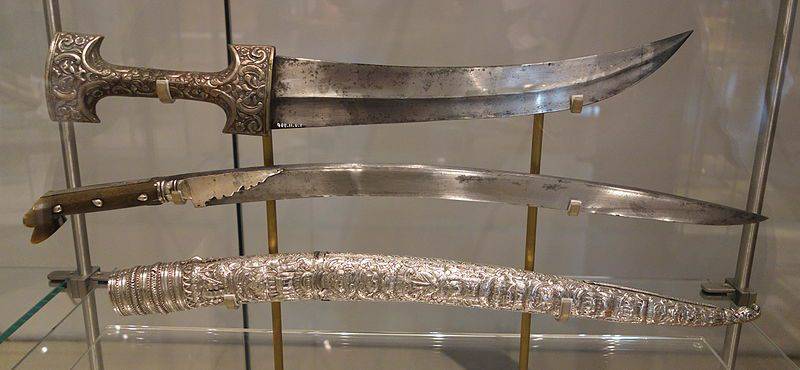
We usually think that a dagger is something rather miniature, whereas a saber or the same Turkish scimitar is something big. Not always like this! Here for example, the Turkish dagger Jambia (above) 18 of the century and the scimitar (below), also Turkish, made in 1866. As you can see, the jambia has downright awesome dimensions compared to this scimitar, although a bit shorter. But not by the way! Royal Ontario Museum, Toronto, Ontario, Canada.
And these are two daggers from North India. Upper - pesh-kabz, which served in order to break through the chain mail, XVII century. But unlike the exhibit of the Metropolitan Museum with a simple bone handle, it has a pistol-shaped handle made of stone with gold inlay.

Well, this knife - it looks very simple, is actually valuable, first of all, not with finishing, but with its material - it is made of meteoric iron! Belonged to Shah Jahangir, Vilik Mughal dynasty, 1621 Exhibit of the Art Gallery of the Smithsonian National Museum of Asian Art in Washington.
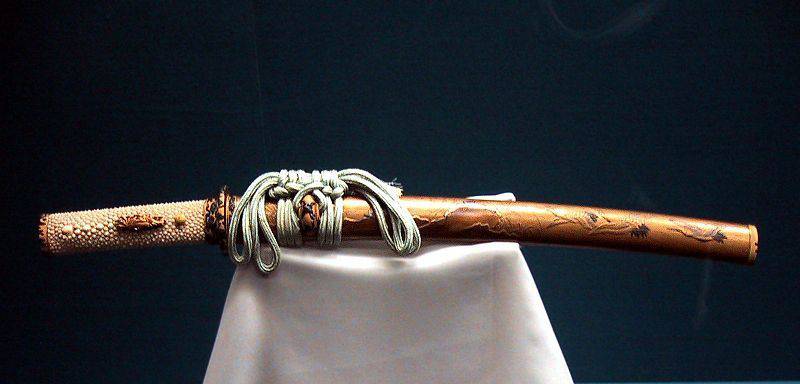
Japanese wakizashi - twin sword to the katana. Why wakizashi, because the pen without braid? And because in this case the length of the blade matters!
Well, now we finally got to Japan. And what we do not see there at all? Well, yes, of course, the abundance of "crooked ninjas"! And the blades of the famous Japanese tati and katan, and the blades of wakizashi and tanto have a very moderate curvature. Because it is more convenient. "Curve" to slaughter is not necessary!
Dagger tantто from the British Museum. As you can see, this is not just a blade mounted on the handle. There are such details as a tsuba (traditionally we call it a guard, although this is not quite so), a sepp coupling, a hubac plate, and also funny accessories — a small kozuka knife and a claw pin. The knife was inserted into the groove of the scabbard (not all tantтоs) and which could have been tossed (although it was unlikely that there was much benefit). More often, they stuck him in the head of the killed enemy (in the ear or in a bundle of hair) to show who killed him, because the name of the owner was engraved on it. The hairpin (one, in this case for some reason two) could be worn in the sheath from the opposite side, or instead of goatsucks. On the hairpin was a spoon - get the sulfur out of the ears. For these items were provided with special holes in the tube.
Here are the most diverse Japanese daggers of the Edo era, that is, peacetime, when their wearing has become a tradition and an indicator of status. George Walter Vincent Smith Museum of Art. Springfield, USA.
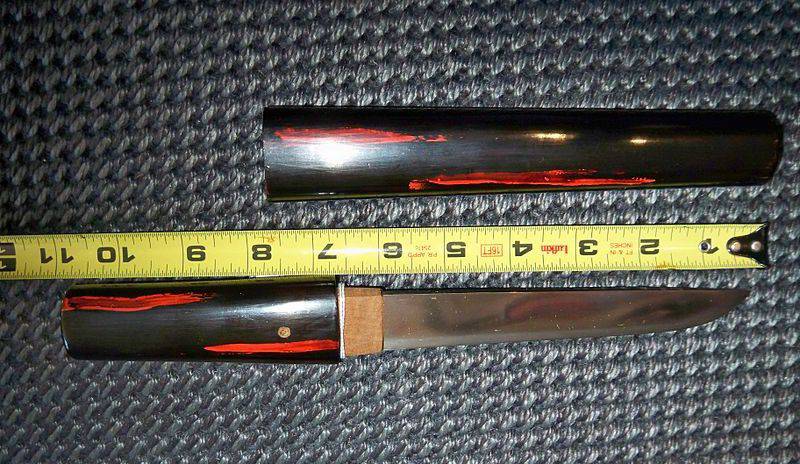
Kaiken - a dagger for women. It was simple in design, but if it was necessary to protect its honor, the Japanese launched it without hesitation, and dealt a fatal blow to the carotid artery.
Well, there were only two main types of daggers: these are tanto and aiguchi. Tanto was a normal-sized guard, but outwardly it looked like a smaller copy of a short sword. Aiguchi (literally - "open mouth") usually did not have a winding on the handle, so the skin of a stingray or shark on it was clearly visible. Aiguchi did not have Garda, he had no sepp washers, and the sheath mount was made in the form of a hanging ring.
Aykuchi. The blade of the master Umetad Akinaga from Yamashiro 1704 of George Walter Vincent Smith. Springfield, USA.
It is believed that samurai usually went to work with tanto, but aiguti was owned by those who had already retired (as proof that they are still suitable for something, because the dagger, although without a guard, is still a dagger). The samurai and the original stylet were used - hashiwara, and the samurai pierced their shells with a blade, but they also knew double-edged swords having a dol, but attached to a traditional Japanese handle - yorodoshi-tant, and their blades were very similar to the tip of a Japanese su-yari spear.
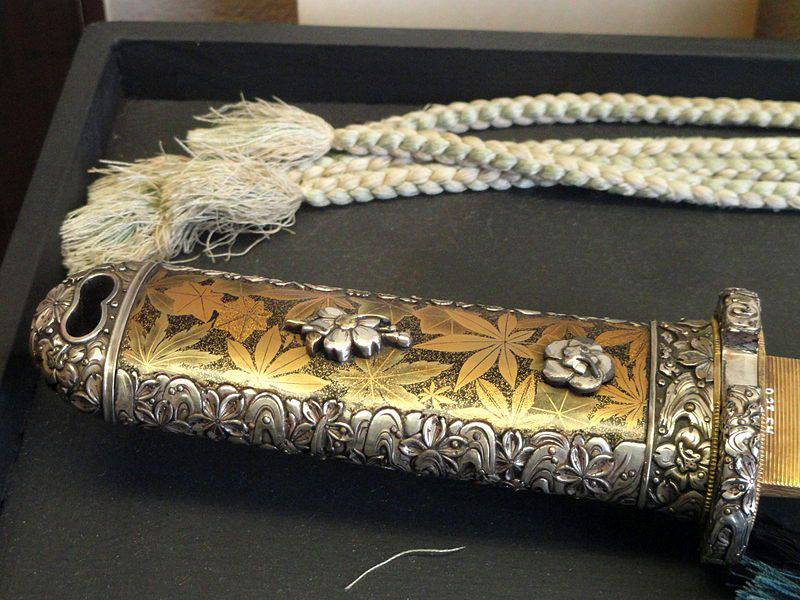
Tanto, signed by Uji Fius. Handle. George Walter Vincent Smith. Springfield, USA.
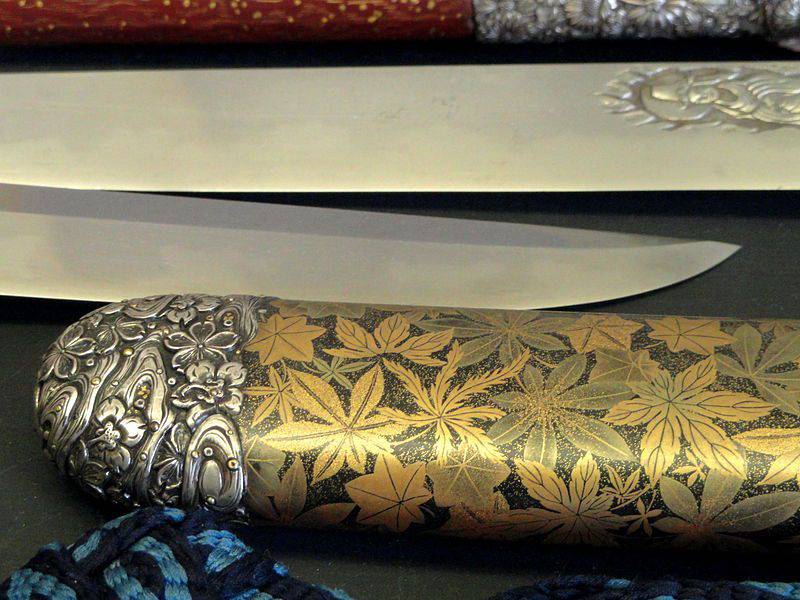
Kojiri - the tip of the scabbard.
Tanto - Masamune blade. Tokyo National Museum.
Kubikiri-zukuri, too, was sharpened on the contrary, and moreover, he did not have an edge. The word "kubikiri" means "head cutter," so what was it meant for clearly? And why should he then the edge? Such daggers were carried by samurai servants, with its help they cut off the heads of dead enemies, since they served as "war trophies." True, by the 17th century, zuburiri-zukuri were already worn as a sign of distinction. "They say, that's what I got from my warlike ancestors - look!"
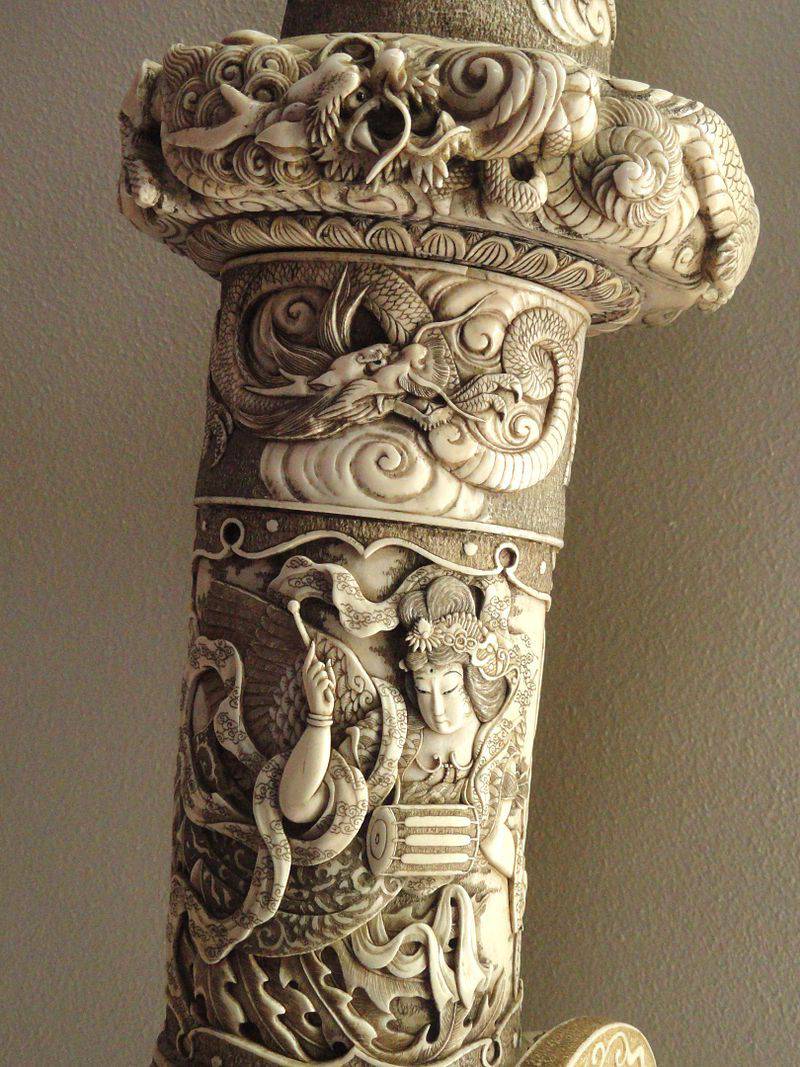
During the period of peace in Japan, a lot of openly decorative weapons were produced. Here is a dagger in ivory sheath, with the same tsuba and grip. George Walter Vincent Smith. Springfield, USA.
Kusungobu is a dagger for hara-kiri. Its length was about 25 cm. If the samurai lacked this dagger, hara-kiri could be done with the help of tantто and even wakizashi, but then the latter was held not by the hilt, but by the blade, for which he was wrapped in rice paper. How it all happened is well shown in the movie "The Shogun."
Purely Japanese weapons of self-defense were dzhytal jute. His cylindrical or multifaceted blade had neither a blade nor a pronounced tip, but on the side he had a massive hook. This weapon, moreover, usually a pair, was used by the Japanese police during the Edo period in order to disarm the enemy armed with the sword. To this end, with a blade and a hook off the side, they caught his sword, after which they pulled out or broke it with a blade blow. To the ring on the handle was attached a lanyard with a colored brush, according to the color of which one could judge the rank of a policeman. There were whole schools that developed in their walls the art of fighting in jutte and, first of all, the techniques of countering these daggers to fighters with a samurai sword.

This jute is very interesting for its guard, and is quite rare in collections. He was called the “power of ten hands,” and he often replaced the short belt sword with a wakizashi or tanto at official receptions or during visits to pubs with samurai of various ranks and clans. This weapon had a large number of options, from the simplest to the most valuable and very expensive, which received with the coming of time the title of kokuho (“national treasure”). He was often supplied with tsuba and scabbards. The length of this sample 47, see. Weight 1, 2 kg.
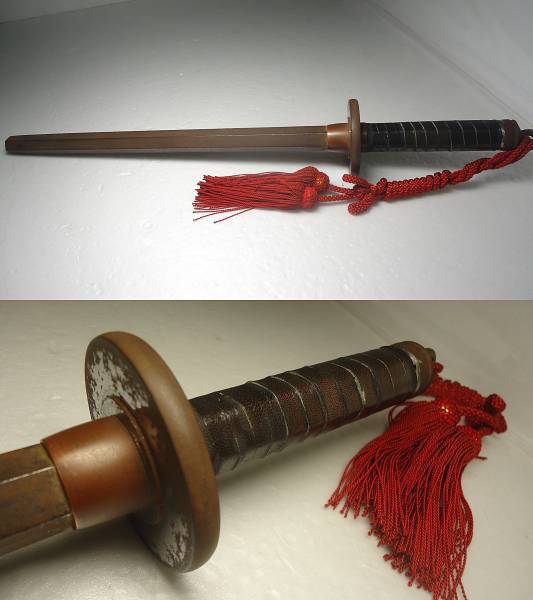
Jutte an Edo-era police officer.
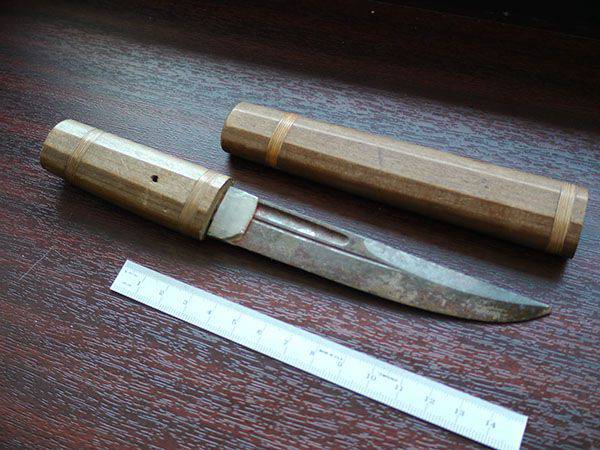
Knife to a simp kamikaze of times of the Second World War. The original is “dressed” in the syros of the statutory procedure (storage sheath). The quenching line of jamon is not visible, but if the blade is polished, it will necessarily appear.
That is, the Japanese rightly reasoned that in order to slaughter either themselves or their neighbors “beautifully” it is not at all necessary to bend the blade of a knife or dagger too much, and that in order to use it neither gold, nor diamonds, nor jade, in general, is also not needed. Living on the ocean, they didn’t even use corals for decoration, they practically didn’t use them, unlike the Turks. Wood, stingray leather, a bit of its famous lacquer, a few brush strokes of gold and - most importantly, almost straight, a sharp blade sharpened on one side and that’s it. That is quite enough!
The author expresses gratitude to the company Antiques of Japan (http://antikvariat-japan.ru/) for the opportunity to use photos and materials belonging to her.
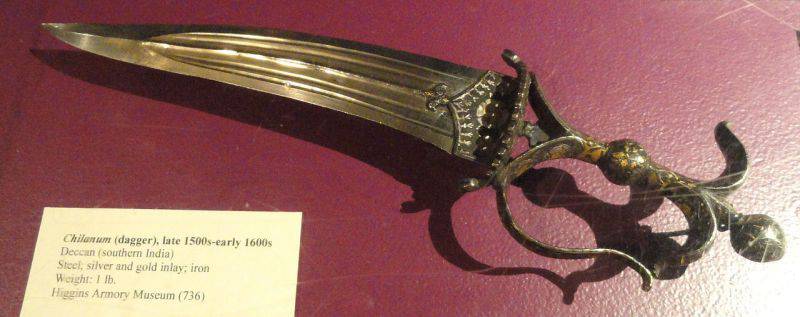
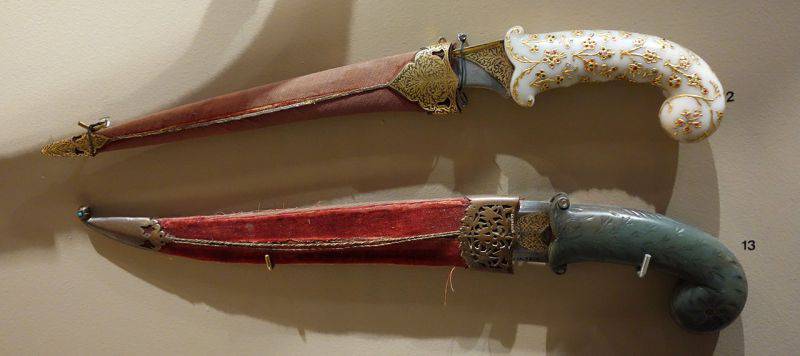
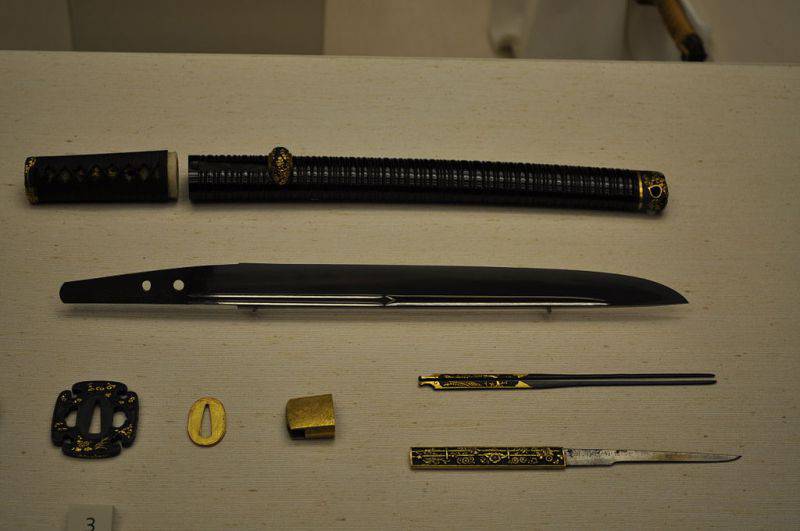
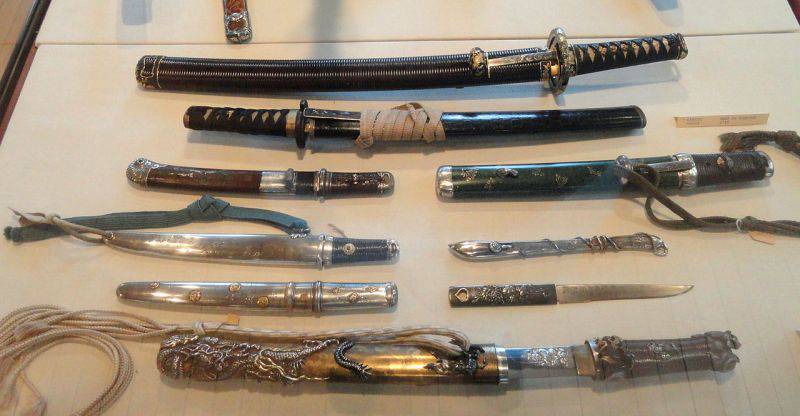
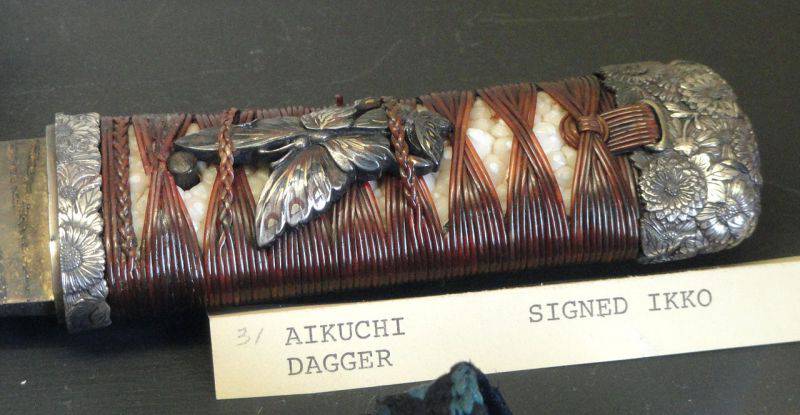
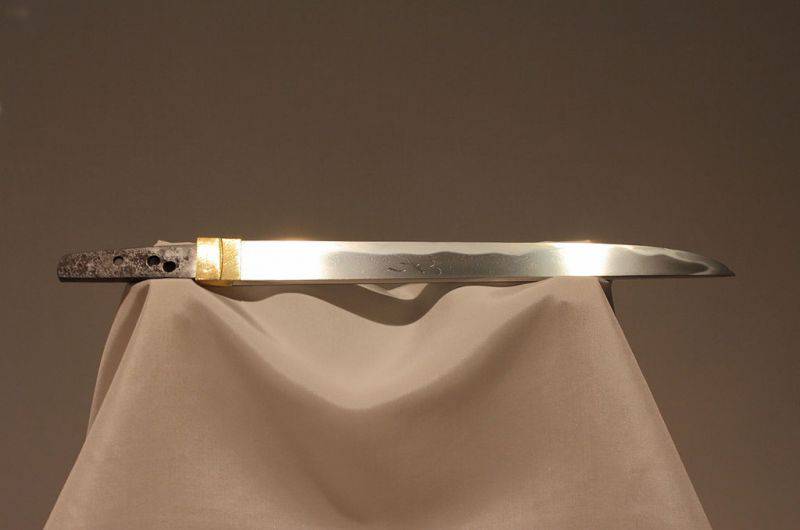
Information